
Outlines the devastation the atomic bomb had on Hiroshima and Nagasaki, Japan.
- Subject:
- Social Studies
- Material Type:
- Reading
- Provider:
- Yale University
- Provider Set:
- The Avalon Project
- Date Added:
- 08/28/2023

Outlines the devastation the atomic bomb had on Hiroshima and Nagasaki, Japan.
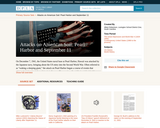
This collection uses primary sources to compare American responses to Pearl Harbor and September 11. Digital Public Library of America Primary Source Sets are designed to help students develop their critical thinking skills and draw diverse material from libraries, archives, and museums across the United States. Each set includes an overview, ten to fifteen primary sources, links to related resources, and a teaching guide. These sets were created and reviewed by the teachers on the DPLA's Education Advisory Committee.
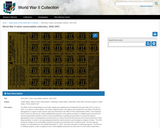
World War II ration memorabilia collection, 1942-1947.
The Office of Price Administration and Civilian Supply was established by Presidential Executive Order 8734 on April 11, 1941, in an effort to control inflation. The civilian supply function of the agency was transferred to the Office of Production Management in August of 1941 and the name was shortened to the Office of Price Administration (OPA). The Emergency Price Control Act (January 30, 1942) established the purposes of the agency as follows: to stabilize prices and rents and prevent unwarranted increases in them; to prevent profiteering, hoarding and speculation; to assure that defense appropriations were not dissipated by excessive prices; to protect those with fixed incomes from undue impairment of their living standards; to assist in securing adequate production; and to prevent a post-emergency collapse of values." The OPA fixed price ceilings on all commodities except farm products and controlled rents in defense areas. The first rationing program, for automobile tires, was initiated December 27, 1941. There were two types of rationing programs. The first was a certificate program, where an applicant had to meet eligibility standards and show need to a local ration board before receiving a certificate permitting purchase of the rationed item. This type of program was applied to ties, automobiles, typewriters, bicycles, rubber footwear and stoves. The second program was a coupon or stamp type for which all civilians were eligible. These programs were administered through local banks and covered foods, fuel oil, gasoline and shoes. Rationing continued throughout World War II and by the end of November 1945 only the sugar and rubber tire rationing programs remained. Tire rationing ceased on December 31, 1945. Sugar rationing continued until June 11, 1947. The Office of Price Administration was dissolved April 1, 1947.

Provides an overview of the events that led up to the outbreak of World War II beginning with the conflicts in Asia in the decades preceding the war. [7:55]
Khan Academy learning modules include a Community space where users can ask questions and seek help from community members. Educators should consult with their Technology administrators to determine the use of Khan Academy learning modules in their classroom. Please review materials from external sites before sharing with students.

Collection of visual resources designed to engage learners in historical thinking; that is, learning to think like historians. Activities and visuals focus on a forty-year period in American history, from 1880 to 1920, making relevant a range of issues and events such as women's rights, World War II, and life on the prairie.

On September 1, 1939, Germany attacked Poland. Hours later, Neville Chamberlain spoke to the members of the House of Commons. The gist of the speech was preparing Britain for war.

Video [1:21:02] published in 1945 by the Department of War in conjunction with British Government surveys entire WWII campaign in Western Europe from just before D-Day to the surrender of Germany in May 1945.

Ibiblio.org offers links to three documents signed by Germany, Japan, and Italy during World War II.

This is a collection of three video lessons from MASTERPIECE: Historical Drama "World on Fire" based on events in England in the 1940's.

Table broken down by country showing estimated numbers of Jewish people killed in each area during World War II.

Here you will find a video and photo gallery of the plane that dropped the first atomic bomb. This is the online version of the former exhibition of the plane.
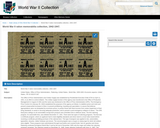
World War II ration memorabilia collection, 1942-1947.
The Office of Price Administration and Civilian Supply was established by Presidential Executive Order 8734 on April 11, 1941, in an effort to control inflation. The civilian supply function of the agency was transferred to the Office of Production Management in August of 1941 and the name was shortened to the Office of Price Administration (OPA). The Emergency Price Control Act (January 30, 1942) established the purposes of the agency as follows: to stabilize prices and rents and prevent unwarranted increases in them; to prevent profiteering, hoarding and speculation; to assure that defense appropriations were not dissipated by excessive prices; to protect those with fixed incomes from undue impairment of their living standards; to assist in securing adequate production; and to prevent a post-emergency collapse of values." The OPA fixed price ceilings on all commodities except farm products and controlled rents in defense areas. The first rationing program, for automobile tires, was initiated December 27, 1941. There were two types of rationing programs. The first was a certificate program, where an applicant had to meet eligibility standards and show need to a local ration board before receiving a certificate permitting purchase of the rationed item. This type of program was applied to ties, automobiles, typewriters, bicycles, rubber footwear and stoves. The second program was a coupon or stamp type for which all civilians were eligible. These programs were administered through local banks and covered foods, fuel oil, gasoline and shoes. Rationing continued throughout World War II and by the end of November 1945 only the sugar and rubber tire rationing programs remained. Tire rationing ceased on December 31, 1945. Sugar rationing continued until June 11, 1947. The Office of Price Administration was dissolved April 1, 1947.
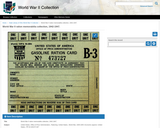
World War II ration memorabilia collection, 1942-1947.
The Office of Price Administration and Civilian Supply was established by Presidential Executive Order 8734 on April 11, 1941, in an effort to control inflation. The civilian supply function of the agency was transferred to the Office of Production Management in August of 1941 and the name was shortened to the Office of Price Administration (OPA). The Emergency Price Control Act (January 30, 1942) established the purposes of the agency as follows: to stabilize prices and rents and prevent unwarranted increases in them; to prevent profiteering, hoarding and speculation; to assure that defense appropriations were not dissipated by excessive prices; to protect those with fixed incomes from undue impairment of their living standards; to assist in securing adequate production; and to prevent a post-emergency collapse of values." The OPA fixed price ceilings on all commodities except farm products and controlled rents in defense areas. The first rationing program, for automobile tires, was initiated December 27, 1941. There were two types of rationing programs. The first was a certificate program, where an applicant had to meet eligibility standards and show need to a local ration board before receiving a certificate permitting purchase of the rationed item. This type of program was applied to ties, automobiles, typewriters, bicycles, rubber footwear and stoves. The second program was a coupon or stamp type for which all civilians were eligible. These programs were administered through local banks and covered foods, fuel oil, gasoline and shoes. Rationing continued throughout World War II and by the end of November 1945 only the sugar and rubber tire rationing programs remained. Tire rationing ceased on December 31, 1945. Sugar rationing continued until June 11, 1947. The Office of Price Administration was dissolved April 1, 1947.
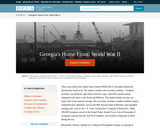
Three years before the United States entered World War II, President Roosevelt declared the South to be "the nation's number one economic problem." Georgia's economy was distinctly agricultural and low-wage, with little manufacturing compared with states in the North and Midwest. The median family income was nearly half of the national average. One year later, an influx of federal defense money established new industries, such as the Bell Aircraft plant in Marietta, and expanded existing ones, such as the J. A. Jones Construction Company in Brunswick. While 320,000 Georgians served in the United States Armed Forces, tens of thousands of Georgians repaired aircraft, built B-29 bombers, and worked in shipyards at home during the war. Meanwhile, military training was widespread throughout Georgia, occupying its fields as well as skies. Capitalizing on the state's flat coastal region and mild winters, Army airfields were installed in Savannah, Statesboro, Thomasville, and Waycross, and pilots trained in Albany, Augusta, Americus, and Douglas. Thousands of soldiers passed through Fort Benning and Fort Oglethorpe, where members of the Women's Army Corps trained for positions at home and abroad. World War II employment was crucial to the economic development of the state, ushering in the transformation to a modern, industrial, and diverse Georgia. This exhibition was created as part of the DPLA's Public Library Partnerships Project by collaborators from the Digital Library of Georgia and Georgia's public libraries. Exhibition organizers: Mandy Mastrovita and Greer Martin.
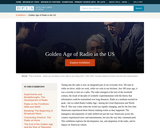
Tuning into the radio is now an integrated part of our everyday lives. We tune in while we drive, while we work, while we cook in our kitchens. Just 100 years ago, it was a novelty to turn on a radio. The radio emerged at the turn of the twentieth century, the result of decades of scientific experimentation with the theory that information could be transmitted over long distances. Radio as a medium reached its peakåÑthe so-called Radio Golden AgeåÑduring the Great Depression and World War II. This was a time when the world was rapidly changing, and for the first time Americans experienced those history-making events as they happened. The emergence and popularity of radio shifted not just the way Americans across the country experienced news and entertainment, but also the way theyåÊcommunicated. This exhibition explores the development, rise, and adaptation of the radio, and its impact on American culture.

This site has the story of an anti-Nazi resistance movement in Germany during World War 2 written by one of the participants. Includes primary documents on the trials held after their capture.

This 15-minute video lesson gives a basic overview of U.S. history from World War II to the Vietnam War. It briefly looks at Hitler, the Cold War, the Bay of Pigs, the Cuban Missile Crisis, and the Space Race. [History playlist: Lesson 4 of 26]
Khan Academy learning modules include a Community space where users can ask questions and seek help from community members. Educators should consult with their Technology administrators to determine the use of Khan Academy learning modules in their classroom. Please review materials from external sites before sharing with students.

This page discusses in detail what happened to the persecuted Romani people during the Holocaust. It also provides links to further content about lives of Roma and Sinti people during this period.

This incredible site outlines the rise and implementation of the Nazi Party in Germany. While learning about Hitler's transformation of Germany, explore the incredible pictures, audio clips, maps, video clips, and an interactive quiz.

Ibiblio.org offers a text versions of three speeches given by Neville Chamberlain, prime minister of Britain, responding to Germany's invasion of Poland. Audio can be downloaded.